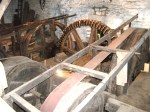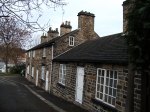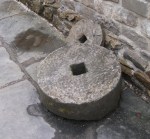Barstow asked “Do you ever sleep with firearms loaded?” –“Always”.
In the 1840s the disputes between Unions and manufacturers started to take a more militant turn due to several factors. The population was expanding rapidly in Sheffield and production was on the increase, but the Journeyman had been replaced with young cheap labour without apprenticeships or job security. Going on strike could mean you not only lost your pay but also could see you in court for breach of contract.
From the management side trade was very up and down and it often proved hard to have sustained periods of work. Cuts were made where they could and that usually meant the older more experienced worker being replaced. Extreme weather, poor harvests and the threat of the Workhouse made working men desperate.
The main way of making a protest beside walking out was sabotage known as Rattening. Non union workers found tools disappearing or the bands from the wheel removed with a note left behind suggesting if they paid their union dues they might find their tools in a certain spot. Quite possibly Rattening had always been a way of protesting against an employer before this period when even grouping together to discuss pay could find you in Jail. Early examples of Rattening did no long lasting damage but as time went on rattening was more a case of attacking wheels and manufacturers who had none Union labour or unqualified men. This more violent behaviour was referred to as the “Outrages”.
In 1859, when the saw grinder, James Linley, was accused by the union of taking on too many apprentices, he was followed around Sheffield for several weeks before being shot and killed. Two years later, a house in Acorn Street was attacked with gunpowder and an innocent lodger was killed. In 1860 Dronfield works had several arson attacks and bellows were shredded.
But violence did not only come from the Union side. A group of women Buffers in 1859 complained about their employer using thugs with clubs to beat up any union man that tried to approach their company. They walked out and found themselves in court for breach of contract. The courts described these 30 year old married women as “foolish virgins” and sent them back to work to work off their notice.
By 1867 due to pressure from people , including Joshua Tyzack , who had formed a deputation to lobby parliament, Gladstone, the Prime Minister instigated a Royal Commission Inquiry. Considering this extreme violence had been going on for 25 years this would seem a somewhat slow response. Rattening and Intimidation had driven some manufacturers out of business and caused uncertain employment and fear for the ordinary law abiding worker. Most probably the commission came about more as a means for gathering evidence about Trade Unions. Surprisingly a number of positive laws for Trade Unions were made in the next few years.
In 1871 the law gave Unions official recognition, another laws by making embezzlement of Union funds illegal also meant all expenditure had to be accounted for. Workers were also allowed to prosecute their employer for breach of contract and picketing was legalised.
The Enquiry seemed to have had very little impact on the practice of rattening as many more incidents were reported in the papers after the enquiry.
1868 bands were removed from the Leather Wheel in Whitely Woods.
Little London Wheel broke into and 3 bands removed
1870 Norton Hammer 4 wheelbands destroyed
1871 Norton Hammer was attacked and six wheel bands destroyed.
1872 Linnekers works was broken into and bands were removed.
Whirlow wheel glazing bands and drive band were removed.
1874 Norton Hammer was again attacked and bolts were removed from the machinery.
On the whole the more extreme violent action does seem to have died out though in 1881 two men were arrested while they were attempting to blow up the Staniforth works at Hackenthorpe.
In the Enquiry Joshua stated that only about 1 in 50 incidents were reported and he had little faith in anything being pursued.
There would appear to be only one case reported in the papers. In 1847 a woman scissor manufacturer Mrs. Sarah Shackley took the treasurer of the Scissor makers Union, John Wreaks, to court for intimidation. It was argued that as she was a woman and as the statute was written referring to only male gender he should be acquitted. The court made no such distinctions and he was found guilty and sentenced to 3 months hard labour.
Joshua Tyzack’s account of the shooting seems to be strangely accepting of the situation.
How do you generally go home? — I formerly used to ride on horseback, afterwards I took a gig, and since then I have gone in the phaeton.
What time did you usually return? — About half past eight.
What occurred when you were shot at? How far had you got from Sheffield? — About three quarters of a mile.
That was just beyond Broadfield Bar, in a small plantation? What happened?— I heard a shot fired.
What followed? — Another shot immediately. I looked in the direction they came from; the moment I turned I saw a flash of a third shot.
Was it from a man in the road or in the field? — From under a broken down fence near Mr Cockayne’s residence.
Did anything follow? —Immediately I saw the flash, a bullet went through the brim of my hat and knocked a piece out the size of half-a-crown.
What happened then? —I was thoroughly unconscious for the moment.
Did you continue standing as you were? —No, I dropped down from the excitement of the passing of the shot through the hair and hat.
Were you knocked down? —No, it was excitement, momentary excitement; I dropped down into the bottom of the gig.
Could you tell what the shot was from? — I think it was a revolver.
Is that from the fact of there being several shots, or from the noise? — From the number of shots that were sent.
Do you know how long you were at the bottom of the gig? — It would be difficult to say, perhaps thirty or forty seconds.
Then you recovered yourself? — My impulse dictated that I should go.
What did you do? — I struck the horse a violent blow.
And what else happened? — There were two other shots as quickly upon each other as possible as soon as the horse got into action.
The enquiry asked why he hadn’t reported the shooting to the police.
You never communicated it to the police although you had been shot at five times? —
No, I had good reason. I had only recently married, and my wife was a stranger here, and she was unsettled and unhappy.
So you wished to keep it concealed from her? — Yes.
Did she know that you were shot at? — Not till about a month after, when I gradually broke the matter to her.
That seems a very poor reason for not communicating it to the police; did you not think it your duty to come forward and try to find out the offender? — I do not see what advantage that could give anyone.
Do you think that you behaved in a manner consistent with your duty in not prosecuting the affair? — I saw no chance of redress.
You took no means to find out? — I thought further investigation would be fatal to me.
Did you think that a manly course to be deterred by fear from doing what you were bound to do? — That was the course I took, and a straightforward course too.
It was a straightforward course one way but it was a straightforward course backwards. When the men had left without notice, had you taken out a summons against them? —No, because we are thoroughly cowed by the operation that is practised towards us. I did not for the same reason that I spoke about in the shooting case.
Does not it strike you that if the perpetrators of these outrages had known that you would prosecute them vigorously, they might have been thoroughly cowed? — I believe that out of the number of cases occurring in Sheffield in reference to trade disputes there is not one in fifty that goes to our bench, for they are perfectly powerless in the matter.
Are you a magistrate? — I am.
In February 1867 three months before the enquiry Joshua Tyzack did prosecute George Peace for assaulting him at the Little London Works. George Peace was later to appear at the enquiry accused of conspiring with Broadhead to have Elisha Parker put out of the picture, although direct collusion was never proved.
The image that comes across from the Enquiry and the Newspapers is of a lawless town in the Wild West where even the sheriff is too scared. A savage time. Not only savage in respect of trade union outrages but in the deaths of ordinary working men going about their work.
In 1834 John Swift grinder, was killed by a breaking of a grinding stone at Whiteley Woods Wheel
In 1847 another grinder was killed at the Little London Works when the grinding wheel shattered and pieces hit him in the head. This was not an uncommon happening. In the case of this stone it was thought that the stone was badly stored and had absorbed water so making the wheel unbalanced.
‘1.Most cases come under the first head. The makers at the quarry put down as the workers faulty, being piece workers , try to hide a flaw or crack if they can. The quarryman ought to be paid for the work he has done, whether there is a flaw in the stone or not. Thinks that the quarrymen 9 times out of 10 know the cause of the breaking of the stone . Even the grinders will take the risk and work with a defective stone in the hope it will not fly. Re dressing is a very bad practice. They take the flaw out and make it look new. They ought to sell the stones as re dressed not new. 2. Under the second head stones are left exposed to the weather in the store, both at the quarry, at the merchants , and at the grinders. The stone absorbs moisture at the bottom, and if heavier at one end bumps and breaks. 3. Imperfect bedding of the plates act so the side surface of the stone is not even. The pressure put on cracks it. Many sickle-grinders ‘ stones are thus cracked.4. If the stone is softer than the grinder requires, he runs it faster in order to get the work out of it. The softer it is the more liable to fly with overspeeding. 5. If the stone be left all night with its lower part resting in water and there should be a fire in the shop in which the top part is exposed, the stone gets out of balance, it bumps and breaks. Handed in a price list from the merchants showing that they will not be responsible for cracks or flaws. Witness feels very strongly on redressing. Would make it a criminal offence to redress a stone and sell it as new. ‘ Dangerous Trades Committee.
In 1891 a grinder was crushed under a grinding stone when they were transferring a grinding stone across an uneven ground. Health and Safety was certainly not all it could be and in 1870 the boiler blew up killing a furnace man through Tyzack’s failure to make sure the boiler was kept fired during the cold winter months.
A slower death emerged for the Grinders. This was caused by the dust rising from the grindstones as they worked . Grinding had once been a seasonal occupation but ,with mass production came also grinding all year round. Grinders developed Grinders Asthma which generally resulted in an early death before the age of 30.
Life in general could be very dangerous.





Very interesting article on Bishops House. Just for interest there will be a spinning and weaving demonstration there on the 18th May. It will be demonstrated by the Hallamshire Weavers, Spinners and Dyers Guild.
It is always and interesting day.
Amanda
Yes Thought so last time I was there. Timewalk project still waiting to form link so they can advertise their events as definitely comes under the term heritage.